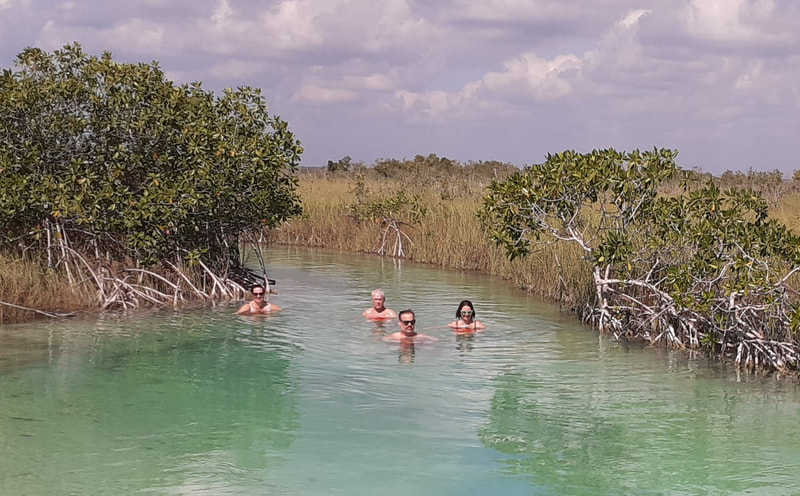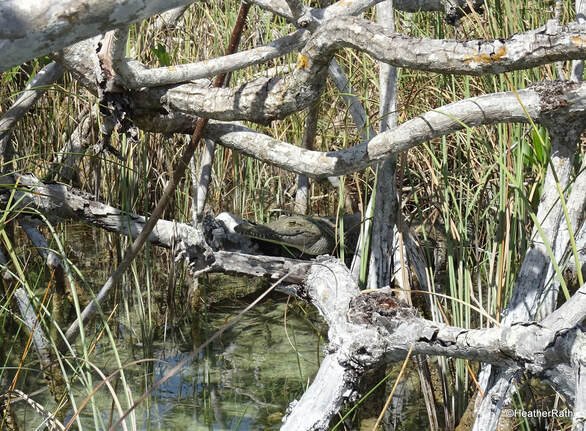We are driving along the congested main road through Tulum in the Mayan Riviera in Mexico. Despite the early hour, it is beastly hot with mucho, mucho traffico: cars, bicycles, motorcycles, street carts, mopeds. pedestrians…
Our plan is to zip through this tourist-mad metropolis (once so peaceful when we visited the ruins in the seventies!) to find a highly-rated UNESCO protected biosphere near the sea called Sian Ka'an.
The big attraction – here where the sky is born – is to body-float down a Mayan made channel for about a half hour. The fresh water is aqua in colour, clear, and pleasantly cool but with a current that carries you along slowly to the sea.
Our reason for hurrying? As independent travellers, we want to beat the hordes of tourists in the tourist buses that arrive later.
The biosphere
Sian Ka’an is officially home to 9 different ecosystems and a wealth of flora and fauna, including: 320 bird species, around 100 mammals, 90 species of native bees, 47 species of dragonflies, 74 species of beetles, 310 species of mosquitos (no, you can’t bring mosquito spray, sorry!), 318 species of butterflies, 84 species of coral, and 5 neotropical felines (i.e. jaguar, jaguarundi, ocelot, margay, tigrina).
So, you get the picture. An awesome biosphere. Our Maya boatman/guide Demacio can recite almost all of this without thinking/blinking!
Having earned a Bronze Medallion in Lifesaving from the Royal Life Saving Society years ago, I do not fear swimming in/jumping into strange water. But for some reason I chose not to ‘float’ down this beautifully clear, aqua coloured channel lined on both sides with tall stalks of reeds.
Need I add that Norm, my adventurous Beloved, jumped into the channel with gusto? Along with three other tourists from our small motorboat….
After the float, enthusiastically endorsed by Norm et al, our group of five resettled into the motor boat for the ride back over the marsh to shore.
As we began, we noticed the guide in the boat ahead pointing with enthusiasm at something in the reeds. His passengers ooh-ed and ahh-ed. Cameras quickly appeared. Click. Click. Click.
Surely not…?!
Naturally the interest from our group of five was piqued. Motor cut, we slowly floated and followed until we reached the same oohing and ahhing spot. Curious, a fellow passenger in the front peered into the same reed area pointed out to the first boat.
We heard a gasp. Then she points. Grabs her camera.
“Baby croc!” she hisses.
Our heads whip around in the same direction. Demacio, cuts the motor. Cameras click. Click. Click.
At first, Norm and I cannot see this cold-blooded reptile, but then Demacio comes to our aid. “See?! See?!” he points. “Hanging over the branch? See his face? Look! Look!”
Yes. Finally, we see.
Indeed, the baby crocodile is clearly visible.
And my immediate question is: But where is the mother?
But…but…but..
We are still jabbering about this exciting but potentially dangerous discovery after our safe return on land.
And then, the questions jab our brains like needles into our skin:
--is this a real or fake croc? Surely there is no way a thriving tourist enterprise would dare endanger its livelihood by exposing visitors to a crocodile. Right?
--how did our guides know where to look? And if it was real, would they really point it out to visitors?
--we noticed the croc was conveniently ‘discovered’ AFTER the channel float
--we researched whether there are freshwater crocs in this area. YES.
---then we researched…can crocodiles crawl onto low-lying branches? YES.
So, your mission, should you choose to accept it:
Did we -- or didn’t we -- see a live baby crocodile lounging on a branch over the beautifully clear aqua water in the place where the sky is born?






 RSS Feed
RSS Feed